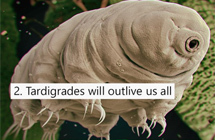2017年:被忽略的七个重大科学发现
|
今年对科学来说又是意义重大的一年,但就算是最疯狂的科学爱好者也可能错过一些不可思议的科学新闻,毕竟每一年都有海量的新研究发布。现在,我们就来分享一下2017年你可能忽略的一些有趣的科学发现,排名不分先后。
1. 两个超大质量黑洞的“双人舞” In June, a large team of hard-working astronomers finally observed something that had been in the works for more than two decades - a pair of orbiting supermassive holes roughly 750 million light years from Earth. It's a theoretical event that should happen after the merging of two galaxies, but until this year, nobody had evidence of it actually happening. And now we do. 2. 缓步类动物才是最终赢家 We already knew that tardigrades are seemingly indestructible, seeing how they can survive being desiccated, extreme heat, extreme cold, and even the vacuum of space. And a study published this year established that tardigrades could survive nearly any apocalypse hurled at us, whether a gamma ray burst or an asteroid impact. 3. 地球生命可能源于陨石 A study spanning research from astrophysics to chemistry and geology has given more weight to the hypothesis that the very first ingredients for life on our planet travelled here through space. The team says that as space rocks splashed into warm, slushy ponds on the surface of Earth, molecules arranged in just the right way to produce RNA polymers. 4. 火星会下雪 In August, planetary scientists revealed something bizarre about Mars's weather patterns - turns out that during the night, there are severely intense snowstorms happening on the planet, basically pelting it with tiny chunks of ice. Given how little water there is, we sure didn't expect that. 5. 百年老药竟对自闭症有奇效 For the first time ever, a medication that's normally used for treating sleeping sickness was tried in a pilot study on a group of boys with autism spectrum disorder (ASD). The results were absolutely astonishing - after just a single dose, their ASD symptoms significantly improved. 6. 糖尿病有重大突破 In April, researchers announced they'd found a brand new type of insulin-producing cell that's been hiding in plain sight, right within the pancreas. These 'virgin beta cells' have opened up new avenues for scientists who are trying to understand type 1 diabetes, and are working to come up with new, better treatments. 7. 物理学家破解“鲁珀特之泪”之谜 Prince Rupert's Drops are these baffling droplets that can be made by dripping molten glass into water. The resulting tear-shaped baubles are incredibly strong on the thick end - you can smack them with a hammer or shoot with a gun, and they won't break. But all you have to do is snap the tail of the droplet, and suddenly the whole thing bursts apart. For around 400 years, researchers have been trying to figure out why that happens. And now we finally know - what a time to be alive! 注:“鲁珀特之泪”之谜的原因就在于表面应力分布——头部的表面压缩应力高达700MPa,是大气压的7000倍,但分布却很薄,只占直径的10%。 |









